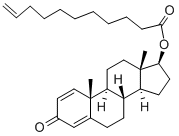Nervonic acid
Synonym(s):cis-15-Tetracosenoic acid;Selacholeic acid
- CAS NO.:506-37-6
- Empirical Formula: C24H46O2
- Molecular Weight: 366.62
- MDL number: MFCD00010507
- EINECS: 610-549-3
- SAFETY DATA SHEET (SDS)
- Update Date: 2024-12-19 09:32:45

What is Nervonic acid?
Description
Nervonic acid, also known as shark oil acid, is a monounsaturated omega-9 fatty acid that exists in nerve tissue and fish oil. It was first discovered in shark brain and is a component of cerebroside, the main source of in shark brain and shark oil. It is also found in the sphingolipids of white matter in human brain. It is the only dual-action miracle substance that can repair nerve fibers that unblock damaged nerve pathways in the brain and promote nerve cell regeneration. Nervonic acid has been identified as important in the biosynthesis of nerve cell myelin. It is used in the treatment of disorders involving demyelination, such as adrenoleukodystrophy and multiple sclerosis where there is a decreased level of nervonic acid in sphingolipids.
Occurrence
Nervonic acid is abundant in King Salmon ( Chinook ) with 140 mg/100g, yellow mustard seed 83 mg/100g , flax seed 64 mg/ 100g, Sockeye salmon 40 mg/100g, sesame seed 35mg/100g, and macademia nuts 18 mg/100g.
The Uses of Nervonic acid
Found in sphingolipids of the white matter of the human brain, neuronic acid is the only magical substance with a dual role in brain development, repairing nerve fibers, unblocking damaged neural pathways in the brain, and promoting nerve cell regeneration. Neuroic acid is very important in the biosynthesis of nerve cell myelin, which together with lignoceric acid accounts for 60% of the acylated fatty acids in white matter sphingomyelin. In demyelinating diseases such as adrenoleukodystrophy and multiple sclerosis, the amount of neuronic acid acylated to sphingolipids is highly reduced, and supplements rich in this fatty acid have been used to help treat these demyelinating diseases.
Definition
ChEBI: Nervonic Acid is a monounsaturated fatty acid with a 24-carbon backbone and the sole double bond originating from the 9th carbon from the methyl end, with this bond in the cis- configuration. It is a metabolite found in the aging mouse brain.
Preparation
Nervonic acid was shown to be identical with selachaleic acid isolated from whale oils. It is obvious that nervonic acid is probably the cis form of erucylacetic acid. Erucylacetic acid has been prepared from erucyl alcohol through the bromide and malonic ester synthesis and has been shown to be identical with nervonic acid obtained from hydrolysis of the cerebroside isolated from human brains.
Nervonic acid is also produced from oleic acid, that undergoes three consecutive chain elongation steps, catalyzed by elongases.Two carbon units are added in each step, with production of gadoleic acid, erucic acid, and finally, nervonic acid.
General Description
Nervonic acids are the products of desaturation and elongation processes of various fatty acids such as palmitic acid, stearic acid, oleic acid, etc.
Biochem/physiol Actions
Nervonic acid (C24:1), a component of membrane sphingolipids and phosphatidylethanolamines, may be a useful predictor of chronic kidney disease mortality and diabetes. Nervonic acid oils are being studied for pharmaceutical, nutraceutical and industrial applications. Nervonic acid is a major component of Lunaria oil.
Source
Sources of Nervonic acid include oil crop seeds, oil-producing microalgae and other microorganisms. Transgenic technology can also be used to improve the source and production of Nervonic acid.
Properties of Nervonic acid
| Melting point: | 42-43 °C (lit.) |
| Boiling point: | 459.84°C (rough estimate) |
| Density | 0.9009 (rough estimate) |
| refractive index | 1.4806 (estimate) |
| Flash point: | >230 °F |
| storage temp. | -20°C |
| solubility | Chloroform (Slightly), Hexanes (Very Slightly) |
| form | Liquid |
| pka | 4.78±0.10(Predicted) |
| color | White to Pale Yellow Low-Melting |
| BRN | 1728551 |
| InChI | InChI=1S/C24H46O2/c1-2-3-4-5-6-7-8-9-10-11-12-13-14-15-16-17-18-19-20-21-22-23-24(25)26/h9-10H,2-8,11-23H2,1H3,(H,25,26)/b10-9- |
| CAS DataBase Reference | 506-37-6(CAS DataBase Reference) |
Safety information for Nervonic acid
| Signal word | Warning |
| Pictogram(s) |
 Exclamation Mark Irritant GHS07 |
| GHS Hazard Statements |
H315:Skin corrosion/irritation H319:Serious eye damage/eye irritation H335:Specific target organ toxicity, single exposure;Respiratory tract irritation |
| Precautionary Statement Codes |
P261:Avoid breathing dust/fume/gas/mist/vapours/spray. P305+P351+P338:IF IN EYES: Rinse cautiously with water for several minutes. Remove contact lenses, if present and easy to do. Continuerinsing. |
Computed Descriptors for Nervonic acid
| InChIKey | GWHCXVQVJPWHRF-KTKRTIGZSA-N |
| SMILES | C(O)(=O)CCCCCCCCCCCCC/C=C\CCCCCCCC |
Nervonic acid manufacturer
JSK Chemicals
New Products
(S)-3-Aminobutanenitrile hydrochloride 4-Methylphenylacetic acid N-Boc-D-alaninol N-BOC-D/L-ALANINOL Tert-butyl bis(2-chloroethyl)carbamate 3-Morpholino-1-(4-nitrophenyl)-5,6-dihydropyridin- 2(1H)-one Furan-2,5-Dicarboxylic Acid Tropic acid 1-Bromo-3,5-Di-Tert-Butylbenzene S-2-CHLORO PROPIONIC ACID ETHYL ISOCYANOACETATE 2-Bromo-1,3-Bis(Dimethylamino)Trimethinium Hexafluorophosphate 4-IODO BENZOIC ACID 3-NITRO-2-METHYL ANILINE 1-(2,4-DICHLOROPHENYL) ETHANAMINE (2-Hydroxyphenyl)acetonitrile 4-Bromopyrazole 2-(Cyanocyclohexyl)acetic acid 4-methoxy-3,5-dinitropyridine 1-(4-(aminomethyl)benzyl)urea hydrochloride 2-aminopropyl benzoate hydrochloride diethyl 2-(2-((tertbutoxycarbonyl)amino) ethyl)malonate tert-butyl 4- (ureidomethyl)benzylcarbamate Ethyl-2-chloro((4-methoxyphenyl)hydrazono)acetateRelated products of tetrahydrofuran
![9,12-Octadecadienoic acid, 27-[[2,3-dihydroxy-1-(hydroxymethyl)heptadecyl]amino]-27-oxoheptacosyl ester, [1S-[1R*(9Z,12Z),2R*,3S*]]- (9CI)](https://img.chemicalbook.in/CAS/20210111/GIF/179186-48-2.gif)







You may like
-
 506-37-6 Nervonic acid,95% 99%View Details
506-37-6 Nervonic acid,95% 99%View Details
506-37-6 -
 cis-15-Tetracosenoic Acid CAS 506-37-6View Details
cis-15-Tetracosenoic Acid CAS 506-37-6View Details
506-37-6 -
 Nervonic acid 95% CAS 506-37-6View Details
Nervonic acid 95% CAS 506-37-6View Details
506-37-6 -
 Nervonic acid CAS 506-37-6View Details
Nervonic acid CAS 506-37-6View Details
506-37-6 -
 Nervonic acid CAS 506-37-6View Details
Nervonic acid CAS 506-37-6View Details
506-37-6 -
 1975-50-4 98%View Details
1975-50-4 98%View Details
1975-50-4 -
 14714-50-2 (2-Hydroxyphenyl)acetonitrile 98+View Details
14714-50-2 (2-Hydroxyphenyl)acetonitrile 98+View Details
14714-50-2 -
 118753-70-1 98+View Details
118753-70-1 98+View Details
118753-70-1